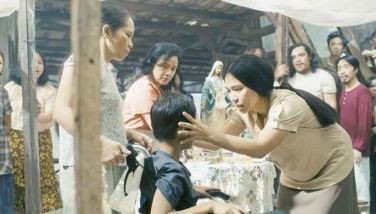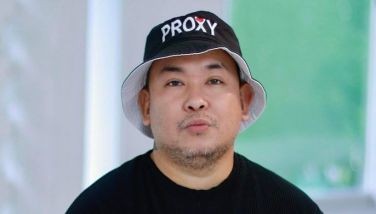How Ryan keeps the music playing
March 21, 2004 | 12:00am
 When eager parents come over to the Ryan Cayabyab Music Studio and tell the owner’s wife, Emmy, that they would like their child to be another Geneva Cruz (whom Ryan trained as member of Smokey Mountain), she (Emmy) smiles and protests, "But we don’t make stars, we make artists."
When eager parents come over to the Ryan Cayabyab Music Studio and tell the owner’s wife, Emmy, that they would like their child to be another Geneva Cruz (whom Ryan trained as member of Smokey Mountain), she (Emmy) smiles and protests, "But we don’t make stars, we make artists."
That’s what the music school named after its multi-awarded owner has been doing for the past 18 years (they’re the longest tenant at the Sunvar Plaza in Amorsolo, Makati): develop musicianship. That’s the all-important first step in the game.
The rest, as Mr. C (Ryan’s moniker in industry circles) puts it, is up to the student.
A look at the one-on-one courses shows why.
Musikgarten starts ‘em as young as two (to seven). The course develops musicianship through ear training, rhythmic movement, singing and dramatizations.
Another enriching kiddie course is the Suzuki Method Piano Lessons for three to six-year-olds. Conceived and developed by Shinich Suzuki, the method enables children to produce beautiful piano tones by listening and following music the teacher plays, supplemented by the recording of the said music.
By the time a child turns eight to 12 years old, his voice is ripe for Young Voices at Work. As they grow older, children 12 and above can study Music Theory, which tackles the rudiments of Music, Solfege and ear training, among others.
Those aged 13 up are ready for regular voice lessons. Designed to keep pace with the student’s needs, the course can be taken continuously.
Specialized Courses in Voice are open to those 15 and above.
Another course, the Vocal Proficiency Program, also for those 15 and above, is for professional singers/vocalists who want to gain vocal skills and proficiency.
The Pop Performer Workshop identifies dos and don’ts in pop singing. The Middle School Math course consists of tutorials for grade three to six students and ties up Music to Math.
Other courses are individualized piano lessons, group vocal training (three to five students), vocal performance program for professional young artists (children eight to 15 years old), chorus classes (female and children’s chorus, with auditions on March 27 to April 3).
Why, one of their courses can even cure tone deafness, says Emmy Cayabyab, or Mrs. C, a graduate of the UP College of Music, where she finished Choral Conducting with honors.
One of their more interesting students is a 72-year-old who used to sing in her younger days and would just like to fine tune her vocal cords to go back to her favorite hobby.
Celeste Legaspi is another enthusiastic student, whose passion for singing has not dimmed through the years. She may not be that active anymore in live performance, but who says Celeste has to neglect that voice that has brought many a fan to heights of musical pleasure?
"The (singing) voice is like a car," declares Emmy. "You need to warm it up for maintenance."
"Otherwise," Ryan chimes in, "it will get rusty."
Rusty is a word the Cayabyabs avoid like the plague. So they go the extra mile to keep this sign of idleness away.
Ryan is the last to rest on his laurels. Other than being the composer/musician that he is, Ryan is Executive and Artistic Director of the newly-formed San Miguel Foundation for the Performing Arts, managing the San Miguel Philharmonic Orchestra and the San Miguel Master Chorale.
Emmy is the conductor of the Vox Lucis community choir and conceptualizes workshops and recitals (held at the end of the course) at the Music Studio (tel. nos. 844-3330, 843-2874, 843-8040 and 09179096484).
Annie Nepomuceno, who teaches Voice at the Music Studio, earned III of a Kind various awards and nominations for their debut album. She has worked as musical arranger for the Philippine Madrigal Singers and has done back-up vocals and arrangements for Sharon Cuneta, Regine Velasquez, Jaya, Lani Misalucha, Rachel Alejandro and the Servant of All albums.
There are 12 faculty members at the Music Studio, which is open year-round, but is especially bursting with students during summer, when the young ones need something worthwhile to do when school is out.
Like all dedicated teachers, the ultimate reward is seeing your students earn applause and honors for their singing. Annie remembers how Dulce expanded range of vocal expression upon enrolling at the Music Studio. Emmy recalls how Regine Velasquez and Janno Gibbs enhanced their ability to attack a song in different ways, thanks to maintenance lessons in voice. There are many others, like Joey Albert, Jolina Magdangal, Roselle Nava and Arnee Hidalgo, recording artists all, who went to the Music Studio at one time or the other.
All of them went through the usual process: their voices were individually evaluated, and a suitable program was designed for their needs.
Celeste, Dulce, Regine, Janno and the others did not have to go through the recital in June to cap the activities. But the rest showcase what they’ve learned by doing so. This year, Emmy says one of the recital pieces is the engaging Alamat ng Dilis, with lyrics by National Artist Rio Almario and music by Ryan Cayabyab.
It promises to be one hell of fun this summer, alright. But the final arbiter, as Ryan himself humbly admits, is not them, but the audience. The audience will decide the fate of those who will graduate from what he calls is his alternative music school.
Judging from its alumni so far, the Music Studio has a good batting average. Besides, years of staying in the business can very well speak for themselves.
BrandSpace Articles
<
>
- Latest
- Trending
Trending
Latest
Trending
Latest
Recommended




















 Exclusive
Exclusive











